| Article ID | Journal | Published Year | Pages | File Type |
|---|---|---|---|---|
| 5449004 | Optics Communications | 2017 | 11 Pages |
Abstract
Suffering from the so-called diffraction limit, the minimum resolution of conventional photolithography is limited to λâ2 or λâ4, where λ is the incident wavelength. The physical mechanism of this limit lies at the fact that the evanescent waves that carry subwavelength information of the object decay exponentially in a medium, and cannot reach the image plane. Surface plasmons (SPs) are non-radiative electromagnetic waves that propagate along the interface between metal and dielectric, which exhibits unique sub-diffraction optical characteristics. In recent years, benefiting from SPs' features, researchers have proposed a variety of plasmonic lithography methods in the manner of interference, imaging and direct writing, and have demonstrated that sub-diffraction resolution could be achieved by theoretical simulations or experiments. Among the various plasmonic lithography modes, plasmonic imaging lithography seems to be of particular importance for applications due to its compatibility with conventional lithography. Recent results show that the half pitch of nanograting can be shrinked down to 22 nm and even 16 nm. This paper will give an overview of research progress, representative achievements of plasmonic imaging lithography, the remained problems and outlook of further developments.
Related Topics
Physical Sciences and Engineering
Materials Science
Electronic, Optical and Magnetic Materials
Authors
Ping Gao, Xiong Li, Zeyu Zhao, Xiaoliang Ma, Mingbo Pu, Changtao Wang, Xiangang Luo,
